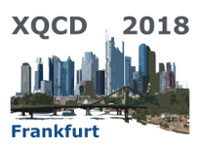Speaker
Prof.
Kyrill Bugaev
(BITP, Kiev, Ukraine)
Description
During last few years our group developed the most advanced model of
the hadron resonance gas [1] which not only allowed us to achieve the best description of all hadronic multiplicities measured from the lowest AGS to the highest RHIC energies, but also to reveal the remarkable irregularities at chemical freeze-out [2-5]. It is intriguing that in central nuclear collisions we found two sets of similar irregularities. The most prominent of them are the sharp peaks of the trace anomaly and baryonic charge density existing at chemical freeze-out at the center-of-mass energies 4.9 GeV and 9.2 GeV [2, 5]. They are accompanied by two sets of highly correlated quasi-plateaus in the collision energy dependence of the entropy per baryon, total pion number per baryon, and thermal pion number per baryon which are found at the center-of-mass energies 3.8–4.9 GeV and 7.6–9.2 GeV [2-4]. The low-energy set of quasi-plateaus was predicted a long time ago. On the basis of the generalized shock-adiabat model I show that the low-energy correlated quasi-plateaus give evidence for the anomalous thermodynamic properties inside the mixed phase found at the center-of-mass energies 4.3–4.9 GeV. Furthermore, based on the thermostatic properties of the mixed phase of a 1-st order phase transition and the ones of the Hagedorn mass spectrum I will explain, respectively, the reason of observed chemical equilibration of strangeness at the collision energy 4.9 GeV and above 8.7 GeV. Also I will argue that the both sets of irregularities possibly evidence for two phase transitions, namely, the 1-st order transition of chiral symmetry restoration in hadronic phase at low-energy range and the 2-nd order deconfinement transition at the higher one. In combination with a recent analysis of the light nuclei number fluctuations our results indicate that the center-of-mass collision energy range 8.8-9.2 GeV may be in the nearest vicinity of the QCD tricritical endpoint [5]. Also I will discuss the properties of the phase of massless hadrons existing between two phase transitions.
1. K. A. Bugaev, D. R. Oliinychenko, J. Cleymans, A. I. Ivanytskyi, I. N. Mishustin, E. G. Nikonov and V. V. Sagun, Europhys. Lett. 104, 22002 (2013).
2. K. A. Bugaev, A. I. Ivanytskyi, D. R. Oliinychenko, V. V. Sagun, I. N. Mishustin, D. H. Rischke, L. M. Satarov and G. M. Zinovjev, Phys. Part. Nucl. Lett. 12, (2015) 238.
3. K. A. Bugaev, A. I. Ivanytskyi, D. R. Oliinychenko, V. V. Sagun, I. N. Mishustin, D. H. Rischke, L. M. Satarov and G. M. Zinovjev, Eur. Phys. J. A 52, (2016) 175.
4. K. A. Bugaev, V.V. Sagun, A. I. Ivanytskyi, D. R. Oliinychenko, E.-M. Ilgenfritz, E. G. Nikonov, A.V. Taranenko and G. M. Zinovjev, Eur. Phys. J. A 52, (2016) 227.
5. K. A. Bugaev, R. Emaus, V.V. Sagun, A. I. Ivanytskyi, L. V. Bravina, D. B. Blaschke, E. G. Nikonov, A. V. Taranenko, E. E. Zabrodin and G. M. Zinovjev, Phys. Part. Nucl. Lett. 15, (2018) 210.
Primary author
Prof.
Kyrill Bugaev
(BITP, Kiev, Ukraine)
Co-authors
Dr
Aleksei Ivanytskyi
(BITP, Kiev, Ukraine)
Prof.
Dirk Rischke
(ITP, Uni. Frankfurt)
Prof.
Edward Nikonov
(JINR, Dubna, Russia)
Dr
Eugene Zabrodin
(University of Oslo)
Prof.
Gennady Zinovjev
(BITP, Kiev, Ukraine)
Prof.
Larissa Bravina
(University of Oslo)
Dr
Violetta Sagun
(BITP, Kiev, Ukraine)

